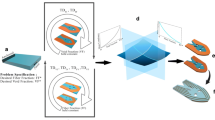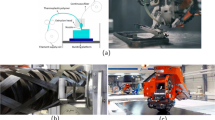Abstract
This work introduces a topology optimization method for the design of structures composed of fiber-reinforced, rectangular plates. Each of the plates has a predetermined, nondesignable reinforcement, and the proposed method determines an optimal layout of the plates within a prescribed three-dimensional region. A plate is modeled using a homogeneous, anisotropic material, whose properties are aligned relative to the plate’s orientation. This work builds upon existing geometry projection techniques with three notable additions. First, it introduces a novel parameterization of the plate orientation based on quaternions, which avoids numerical instabilities and \(2\pi\)-periodicity issues. Second, an overlap constraint for plates is formulated to prevent plate intersections that would make manufacturing of the structure impractical. Finally, the finite element assembly and sensitivity analysis are substantially accelerated by exploiting the structure of the material interpolation. This strategy is facilitated by the use of an adaptive mesh refinement technique. The efficacy of the proposed method is demonstrated with compliance minimization examples. The examples show the importance of considering material anisotropy in the design of composite structures. Moreover, it is demonstrated that naively replacing the material of the plates in an optimally stiff design made of an isotropic material with a composite can result in suboptimal performance.












Similar content being viewed by others
Notes
In previous works, we have referred to the membership variable as a ‘size’ variable. However, this denomination does not have a physical interpretation for 3-dimensional problems.
References
Arndt D, Bangerth W, Clevenger TC, Davydov D, Fehling M, Garcia-Sanchez D, Harper G, Heister T, Heltai L, Kronbichler M, Kynch RM, Maier M, Pelteret JP, Turcksin B, Wells D (2019) The deal. II library, version 9.1. J Numer Math 27(4):203–213. https://doi.org/10.1515/jnma-2019-0064
Bell B, Norato J, Tortorelli D (2012) A geometry projection method for continuum-based topology optimization of structures. In: 12th AIAA Aviation Technology, integration, and operations (ATIO) conference and 14th AIAA/ISSMO multidisciplinary analysis and optimization conference, p 5485
Bendsøe MP, Sigmund O (1999) Material interpolation schemes in topology optimization. Arch Appl Mech 69(9–10):635–654
Boddeti N, Ding Z, Kaijima S, Maute K, Dunn ML (2018) Simultaneous digital design and additive manufacture of structures and materials. Sci Rep 8(1):1–10. https://doi.org/10.1038/s41598-018-33454-3
Daniel IM, Ishai O (1994) Engineering mechanics of composite materials. Oxford University Press, New York
Guo X, Zhang W, Zhong W (2014) Doing topology optimization explicitly and geometrically a new moving morphable components based framework. J Appl Mech 81(8):081009
Hoang VN, Jang GW (2017) Topology optimization using moving morphable bars for versatile thickness control. Comput Methods Appl Mech Eng 317:153–173. https://doi.org/10.1016/j.cma.2016.12.004
Hu Z (2021) A review on the topology optimization of the fiber-reinforced composite structures. Aerosp Technic Technol 3(3):54–72
Hvejsel CF, Lund E, Stolpe M (2011) Optimization strategies for discrete multi-material stiffness optimization. Struct Multidisc Optim 44(2):149–163
Jia HP, Jiang CD, Li GP, Mu RQ, Liu B, Jiang CB (2009) Topology optimization of orthotropic material structure. Mater Sci Forum 575(578):978–989. https://doi.org/10.4028/www.scientific.net/msf.575-578.978
Kazemi H, Vaziri A, Norato JA (2018) Topology optimization of structures made of discrete geometric components with different materials. J Mech Des 140(11):111401. https://doi.org/10.1115/1.4040624
Marsh G (2007) Composites help propel GKN aerospace growth. Reinf Plast 51(7):26–29
Mei Y, Wang X, Cheng G (2008) A feature-based topological optimization for structure design. Adv Eng Softw 39(2):71–87
Nikbakt S, Kamarian S, Shakeri M (2018) A review on optimization of composite structures Part I. Laminated composites. Compos Struct 195:158–185
Nomura T, Dede EM, Lee J, Yamasaki S, Matsumori T, Kawamoto A, Kikuchi N (2015) General topology optimization method with continuous and discrete orientation design using isoparametric projection. Int J Numer Methods Eng 101(8):571–605. https://doi.org/10.1002/nme.4799
Norato J, Bell B, Tortorelli D (2015) A geometry projection method for continuum-based topology optimization with discrete elements. Comput Methods Appl Mech Eng 293:306–327
Shoemake K (1985) Animating rotation with quaternion curves. In: Proceedings of the 12th annual conference on Computer graphics and interactive techniques, pp 245–254
Sigmund O, Maute K (2013) Topology optimization approaches. Struct Multidisc Optim 48(6):1031–1055
Smith H, Norato J (2019) Geometric constraints for the topology optimization of structures made of primitives. SAMPE. https://doi.org/10.33599/nasampe/s.19.1518
Smith H, Norato JA (2020) A matlab code for topology optimization using the geometry projection method. Struct Multidisc Optim 62(3):1579–1594
Smith H, Norato JA (2021) Topology optimization with discrete geometric components made of composite materials. Comput Methods Appl Mech Eng 376:113582. https://doi.org/10.1016/j.cma.2020.113582
Stegmann J, Lund E (2005) Discrete material optimization of general composite shell structures. Int J Numer Methods Eng 62(14):2009–2027. https://doi.org/10.1002/nme.1259
Svanberg K (1987) The method of moving asymptotes a new method for structural optimization. Int J Numer Methods Eng 24(2):359–373
Terzakis G, Culverhouse P, Bugmann G, Sharma S, Sutton R (2012) A recipe on the parameterization of rotation matrices for non-linear optimization using quaternions. Tech. rep., Tech. Rep. 004, School of Marine Science and Engineering. Plymouth University
Venkataraman S, Haftka RT (1999) Optimization of composite panels-a review. In: Proceedings-American Society for Composites, pp 479–488
Wang F, Lazarov BS, Sigmund O (2011) On projection methods, convergence and robust formulations in topology optimization. Struct Multidisc Optim 43(6):767–784
Watts S, Tortorelli DA (2017) A geometric projection method for designing three-dimensional open lattices with inverse homogenization. Int J Numer Methods Eng 112(11):1564–1588
Wein F, Dunning PD, Norato JA (2020) A review on feature-mapping methods for structural optimization. Struct Multidisc Optim 1–42
Xu Y, Zhu J, Wu Z, Cao Y, Zhao Y, Zhang W (2018) A review on the design of laminated composite structures: constant and variable stiffness design and topology optimization. Adv Compos Hybrid Mater 1(3):460–477
Zhang S, Norato JA (2017) Optimal design of panel reinforcements with ribs made of plates. J Mech Des 139(8):081403
Zhang S, Norato JA, Gain AL, Lyu N (2016) A geometry projection method for the topology optimization of plate structures. Struct Multidisc Optim 54(5):1173–1190
Zhang W, Liu Y, Du Z, Zhu Y, Guo X (2018a) A moving morphable component based topology optimization approach for rib-stiffened structures considering buckling constraints. J Mech Des 140(11)
Zhang W, Song J, Zhou J, Du Z, Zhu Y, Sun Z, Guo X (2018b) Topology optimization with multiple materials via moving morphable component (MMC) method. Int J Numer Methods Eng 113(11):1653–1675
Zhang S, Gain AL, Norato JA (2019) Adaptive mesh refinement for topology optimization with discrete geometric components. arXiv:191005585
Zhou Y, Nomura T, Saitou K (2018) Multi-component topology and material orientation design of composite structures (MTO-C). Comput Methods Appl Mech Eng 342:438–457. https://doi.org/10.1016/j.cma.2018.07.039
Zhou Y, Nomura T, Saitou K (2021a) Anisotropic multicomponent topology optimization for additive manufacturing with build orientation design and stress-constrained interfaces. J Comput Inf Sci Eng 21(1):011007
Zhou Y, Nomura T, Zhao E, Saitou K (2021b) Large-scale three-dimensional anisotropic topology optimization of variable-axial lightweight composite structures. J Mech Des 144(1):011702
Acknowledgements
The authors express their gratitude to the US Office of Naval Research, Grant No. N00014-17-1-2505, for supporting to conduct this work.
Author information
Authors and Affiliations
Corresponding author
Ethics declarations
Conflict of interest
The authors declare that they have no conflict of interest.
Replication of results
The manuscript provides all the details of the formulation and all the data necessary to replicate the results presented in the examples. Relevant portions of the code can be shared upon reasonable request by contacting the corresponding author.
Additional information
Responsible Editor: YoonYoung Kim
Publisher's Note
Springer Nature remains neutral with regard to jurisdictional claims in published maps and institutional affiliations.
Appendix: Smooth approximations
Appendix: Smooth approximations
The smooth approximations of the Heaviside and argmax functions used in the formulation and their sensitivities are given by:
Rights and permissions
About this article
Cite this article
Smith, H., Norato, J. Topology optimization of structures made of fiber-reinforced plates. Struct Multidisc Optim 65, 58 (2022). https://doi.org/10.1007/s00158-021-03164-y
Received:
Revised:
Accepted:
Published:
DOI: https://doi.org/10.1007/s00158-021-03164-y




